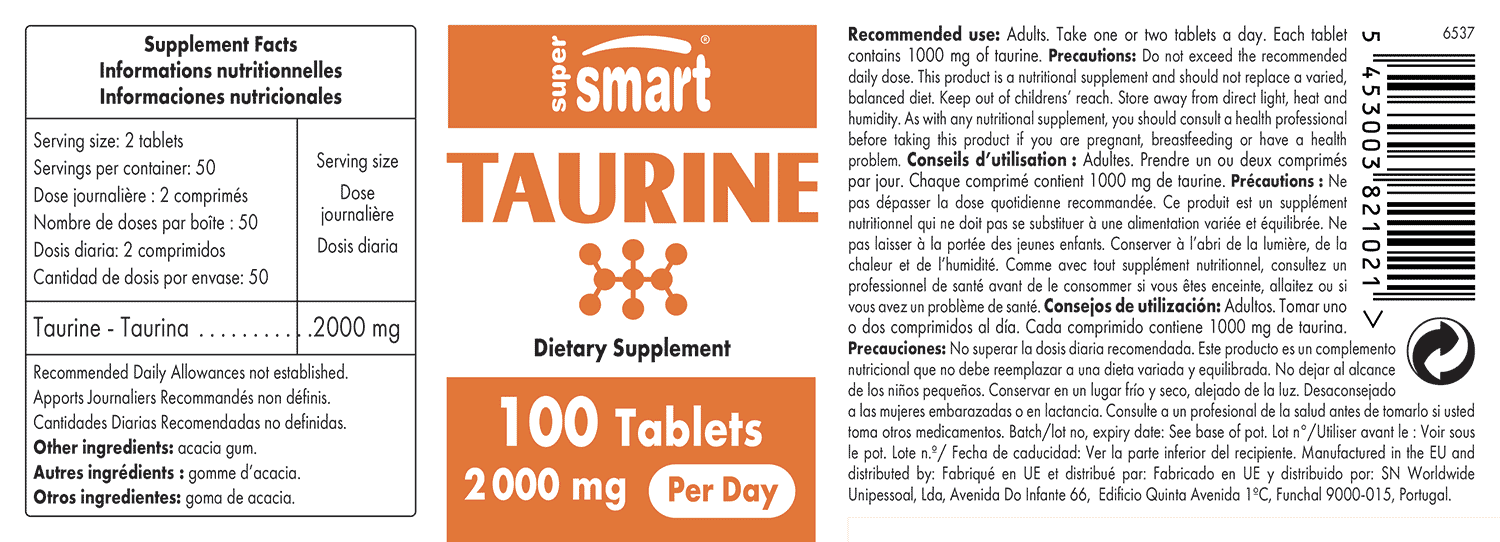

In these studies, taurine protected against renal and liver injury. Ripps 2012, Sarkar 2017Īnimal and in vitro studies confirm that taurine possesses antioxidant activity, which may be one of the mechanisms by which taurine exerts its therapeutic actions. Wójcik 2010 Taurine plays an important role for normal development in humans, particularly in brain and retinal development. A high taurine concentration downregulates the taurine transporter and taurine is excreted by the kidneys reabsorption into the renal tubules occurs if taurine concentration is low. It can enter cells via an active transporter, which then responds to the intracellular concentration. Taurine is absorbed via the small intestine and transported to the liver before being released into circulation. Ripps 2012 Despite taurine's highly polar nature, it crosses the blood-brain barrier.
#Taurine dosage free#
Abebe 2011, Sarkar 2017, Wójcik 2010 It plays a role in the modulation of intracellular free calcium levels. Taurine can be made endogenously in the body from methionine and cysteine in the presence of vitamin B 6, and is a major constituent of bile. It is not a typical amino acid because it has no carboxyl group and is more accurately described as an aminosulfonic acid. Taurine, or 2-aminoethanesulfonic acid, is a derivative of cysteine with high water solubility. Its name derives from the Latin word Bos taurus, meaning "ox" or "bull." Eudy 2013, Ripps 2012 Chemistry Taurine was first isolated from ox bile in 1827 by German scientists Friedrich Tiedemann and Leopold Gmelin. Related/similar drugs turmeric, Ginkgo Biloba, saw palmetto History Higher concentrations occur in the brain, leukocytes, heart, and retina. Caine 2016 Additionally, taurine is found in abundance in the human body, up to 1 g/kg of body weight. Abebe 2011, De Carvalho 2017, Eudy 2013 Typical taurine consumption in the American diet is 123 to 178 mg daily. Energy drinks can contain taurine 1 to 3 g per serving, in addition to other ingredients. A strict vegan diet is likely to have a very limited intake of taurine however, taurine can be manufactured in the body. Froger 2014 It does not appear to be destroyed through cooking. Taurine is an organic acid that occurs naturally in food, especially in shellfish (eg, scallops, mussels, clams) and in the dark meat of turkey and chicken, as well as in other meats and eggs. Information regarding the safety of long-term taurine supplementation is lacking. A proposed safe level of taurine consumption is 3 g/day however, taurine has been tested in doses as high as 10 g/day for 6 months. ToxicologyĬardiovascular events have been reported following excessive consumption of energy drinks however, it is difficult to attribute these events directly to taurine because the drinks contain multiple ingredients and energy drink consumption is often accompanied by excessive alcohol intake or physical activity. No adverse events have been noted for dosages up to 3 g/day. Taurine inhibits cytochrome P450 (CYP-450) 2E1, and any drugs that are substrates of this isoenzyme may be impacted with coadministration. It is also an ingredient in many baby formulas. It may be protective against neural tube defects.

Taurine passes to the developing fetus through maternal circulation during pregnancy and to the newborn via breast milk. Information regarding supplementation above normal requirements is lacking, and caution is warranted. ContraindicationsĬontraindications have not been identified. Portal hypertension: Taurine 6 g/day for 1 month.

Hypertension: Supplemental taurine 3 to 6 g/day (treatment duration range, 1 to 8 weeks). Exercise: Various dosages and treatment durations of taurine, either alone or as part of a combination energy product, have been evaluated for effects on exercise. Chronic hepatitis: Taurine 2 g 3 times daily for 3 months. Taurine has been studied in doses of 1 to 6 g/day. Large quality clinical trials that might establish a definitive place for taurine in therapy are lacking, and results from animal studies have yet to be translated to the clinical setting. Supplemental taurine has been evaluated for use in cardiovascular conditions and diabetes, and for its CNS effects. Common Name(s): 2-aminoethanesulfonic acid, Bos taurus, Tau, Taurine


 0 kommentar(er)
0 kommentar(er)
